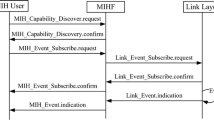Abstract
Current voice codecs like G.729, G.723.1 or AMR can generate short background descriptors (SID) frames during voice inactivity periods for Comfort Noise Generation (CNG). This feature alters the classical on-off traffic pattern typically used to model the traffic generated by codecs with a Silence Suppression scheme. Therefore the CNG feature leads to severe inaccuracies in the dimensioning analysis done through traditional models based on multiplexing on-off sources like MMPP or fluid model.
In this paper, we focus on the VoIP dimensioning issue. First, we define the traffic pattern generated by those codecs that include CNG (generalized VoIP sources). Second, we extend the traditional MMPP and fluid analytical models to multiplex our generalized VoIP sources and propose a simple but efficient dimensioning algorithm. Results are validated by simulations fed by VoIP traces and demonstrate a significant improvement in accuracy with respect to current on-off based approaches.
Similar content being viewed by others
References
Ahlgren, B., Andersson, A., Hagsand, O., & Marsh, I. (2000). Dimensioning links for IP telephony. Sweden Institute of Computer Science (Tech. Rep. T2000:09).
Anick, D., Mitra, D., & Shondi, M. (1982). Stochastic theory of a data-handling system with multiple sources. Bell System Technical Journal, 61, 1871–1894.
Baiocchi, A., Melazzi, N., & Roveri, A. (1991). Queuing performance and control in ATM. In Proceedings of the 13-th international teletraffic congress, Copenhagen (pp. 13–18).
Baiocchi, A., Melazzi, N., Roveri, A., & Winkler, R. (1991). Loss performance analysis of an ATM multiplexer loaded with high-speed ON-OFF sources. IEEE Journal of Selected Areas in Communications, 9(3), 388–393.
Baiocchi, A., & Melazzi, N. (1993). Steady-state analysis of the MMPP/G/1/K queue. IEEE Transactions on Communications, 41(4), 531–534.
Bruno, R., Garroppo, R., & Giordano, S. (2000). Token bucket dimensioning for aggregate VoIP sources. In Proceeding of the IEEE ATM workshop 2000.
Cuevas, A., et al. (2006). The IMS service platform: a solution for next-generation network operators to be more than bit pipes. IEEE Communications Magazine, 44(8), 75–81.
Daigle, J., & Langford, J. (1986). Models for analysis in packet voice communications systems. IEEE Journal of Selected Areas in Communications, 4(6), 847–855.
Estepa, A., Estepa, R., & Vozmediano, J. (2003). Packetization and silence influence on VoIP traffic profile. In Lecture notes in computer science (Vol. 2899, pp. 331–339).
Estepa, A., Estepa, R., & Vozmediano, J. (2004). A new approach for VoIP traffic characterization. IEEE Communication Letters, 8(10), 664–647.
Guérin, R., Ahmadi, H., & Naghshineh, M. (1991). Equivalent capacity and its application to bandwidth allocation in high-speed networks. IEEE Journal of Selected Areas in Communications, 9(7), 968–981.
Heffes, H., & Lucantoni, D. (1986). A Markov modulated characterization of packetized voice and data traffic and related statistical multiplexer performance. IEEE Journal of Selected Areas in Communications, 4(6), 856–868.
ITU-T Recommendation G.729 (1996). Coding of speech at 8 kbit/s using conjugate-structure algebraic-code-excited linear-prediction. Annex B: A silence compression scheme for g.720 optimized for terminals conforming to recommendation v.70.
James, H., Chen, B., & Garrison, L. (2004). Implementing VoIP: a voice transmission performance progress report. IEEE Communications Magazine, 42(7), 36–41.
Jiang, W., & Schulzrinne, H. (2000). Analysis of ON-OFF patterns in VoIP and their effect on voice traffic aggregation. In Proc. of the 9th IEEE international conference on computer communication networks (pp. 82–87).
Kim, S., Lee, M., & Kim, M. (1994). Σ-matching technique for mmpp modeling of heterogeneous ON-OFF sources. IEEE GLOBECOM, 2, 1090–1094.
Nagarajan, R., Kurose, J., & Towsley, D. (1991). Approximation techniques for computing packet loss in finite buffer voice multiplexers. IEEE Journal of Selected Areas in Communications, 9(3), 368–377.
Noirie, L., Douville, R., & Vigoureux, M. (2005). Statistical multiplexing in data-aware transport network. Alcatel Telecommunications Review, 3, 222–226.
Pallares, E., & Garcia, J. (2003). Fluid-flow approach to evaluate the information loss probability in a finite buffering switching node under heterogeneous ON/OFF input traffic sources. Performance Evaluation, 51, 153–169.
Park, L., Baek, J., & Hong, J. (2001). Management of service level agreements for multimedia internet service using a utility model. IEEE Communications Magazine, 39(5), 100–106.
Perkins, C., Hodson, O., & Hardman, V., (1998). A survey of packet loss recovery techniques for streaming audio. IEEE Network, 12(5), 40–48.
Salah, K. (2006). On the deployment of VoIP in Ethernet networks: methodology and case study. Computer Communications, 29(8), 1039–1054.
Schormans, J., et al. (2000). Buffer overflow probability for multiplexed on-off VoIP sources. Electronic Letters, 36(6), 523–524.
Schulzrinne, H. (2003). RTP profile for audio and video conferences with minimal control. RFC 3551.
Sriram, K., & Whitt, W. (1986). Characterizing superposition arrival processes in packet multiplexers for voice and data. IEEE Journal of Selected Areas in Communications, 4(6), 833–846.
Stewart, R., et al. (2000). Analysis of local internet/enterprise networking multiplexer for ON-OFF VoIP sources. Electronic Letters, 36(21), 1825–1826.
Tao, S., et al. (2005). Improving VoIP quality through path switching. IEEE Proceedings of Infocom, 4, 2268–2278.
Tucker, R. (1988). Accurate method for analysis of a packet-speech multiplexer with limited delay. IEEE Transactions on Communications, 36(4), 479–483.
Xiao, X., Hannan, A., Bailey, B., & Ni, L. (2000). Traffic engineering with MPLS in the Internet. IEEE Network, 14(2), 28–33.
Yegenoglu, F., & Jabbari, B. (1993). Performance evaluation of MMPP/D/1/K queues for aggregate ATM traffic models. IEEE Proceedings of Infocom 2003, 3, 1314–1319.
Author information
Authors and Affiliations
Corresponding author
Rights and permissions
About this article
Cite this article
Estepa, A., Estepa, R. & Pacheco, A. Accurate resource estimation for generalized VoIP sources. Telecommun Syst 39, 37–50 (2008). https://doi.org/10.1007/s11235-008-9084-2
Published:
Issue Date:
DOI: https://doi.org/10.1007/s11235-008-9084-2




